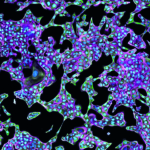Evolution or Revolution?
At present, 5G is still the be-all and end-all in mobile communications and the changeover is in full swing. At the same time, the development of 6G is already in progress – including at the UDE. By Thomas Wittek
Each new mobile communications standard has been associated with the promise of faster transmission, better quality and new applications. Yet what followed was usually not a great technological leap, but rather a step-by-step improvement. The next magic number is 6G. Researchers at the UDE Faculty of Engineering are instrumental in the development of the new technology. Is this one going to be the game changer?
‘The odd numbers are no good,’ says Prof. Dr. Thomas Kaiser tongue-in-cheek. Together with Prof. Dr. Andreas Stöhr from the Centre for Semiconductor Technology and Optoelectronics and a team of colleagues, the head of the Institute of Digital Signal Processing is researching the new transmission technology, which will operate in the high-frequency terahertz range. According to him, the true quantum leaps were brought about by mobile phone standards with even numbers, i.e. 2G and 4G. The researchers have high hopes for 6G, too. For one thing, the volume of transmitted data will be significantly higher. ‘5G is expected to make one to ten gigabytes per second possible,’ explains Stöhr. ‘With the new 6G technology, we are aiming for one terabyte per second, which represents a thousand times the current transmission rate.’ For another, the delay will be much shorter, which means that the transmission will start faster than it does now. Where it takes about 20 milliseconds today, the latency at 6G is expected to be just one millisecond. This is a reaction speed equivalent to that of humans. ‘As a result, it will be possible to run all applications in real time. This truly is a minor revolution,’ points out Kaiser.
A revolution that would lay the groundwork for the breakthrough of many hotly debated technologies of the future, such as self-driving cars. This is one of six fields of application for 6G that are currently being explored in more detail by the researchers. The other five are factories, logistics, rescue robotics, operating theatres and gaming. An exciting aspect is that the extremely high frequencies of 6G not only allow for the fast transmission of large data volumes, but can also be used, for example, to scan rooms or recognise objects and gestures. The latter is already supported today, but only with the help of additional devices such as cameras, data gloves or tracking devices.
The team aims to research the capabilities of this combination under real-life conditions in the next few years in collaboration with the Port of Duisburg and the Essen University Hospital. The plan is to set up two test fields that will be part of a larger 6G hub involving the UDE, RWTH Aachen University, which is coordinating the project, Ruhr-Universität Bochum, TU Dortmund University, three Fraunhofer Institutes and a Max Planck Institute. The hub is one of four such clusters in Germany and will be funded by the Federal Ministry of Education and Research with 43 million euros until 2025. In the next few years, 700 million euros will be invested in researching and testing of 6G, 250 million of which will go to the universities. ‘This large sum offers a chance for Germany to finally take the lead again in a key technology of the future,’ a pleased Kaiser says.
Longstanding research focus on terahertz
The engineering scientists at the UDE departments of electrical engineering and optoelectronics have been researching terahertz technology for ten years. Following the development of a mobile detector capable of analysing materials and locating objects with high-frequency radio waves, the foundation for the works on 6G was laid here in a DFG-funded collaborative research centre*. The UDE is currently developing, among other things, the components for the new transmission and radio technology. ‘Due to the high frequencies, the waves have to be bundled into a thin beam in order to be able to cover greater distances,’ as Stöhr describes the challenge. ‘We’ve succeeded in developing a chip that can not only generate such a bundled beam, but also control the direction of radiation. Moreover, the chip operates not with an electronic but with an optical control. We were the first in the world to do so.’
In the Port of Duisburg, the technology will be used to optimise logistics: for example, a partially automated harbour crane will autonomously load and unload container ships. 6G will facilitate the exact localisation of containers on trains and trucks without additional sensors. Extended reality applications are planned for the Essen University Hospital. A pair of data glasses will make the work of doctors in the operating theatre easier by displaying vital data, high-res 3D images and the next stages of a surgical procedure and the corresponding instruments in real time as soon as surgeons direct their gaze to the relevant area of the patient’s body. The schedule is ambitious: the solutions are expected to be ready for use in as little as three years. Stöhr and Kaiser are optimistic that they can meet this goal. Still, it will take a little bit longer until normal smartphones also run on 6G. ‘The typical development cycle for new mobile phone standards is eight to ten years,’ says Kaiser. ‘So, 2030 is realistic.’
* CRC/TRR 196 MARIE: Mobile Material Characterisation and Localization by Electromagnetic Sensing



